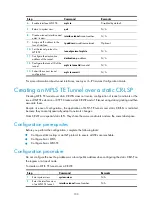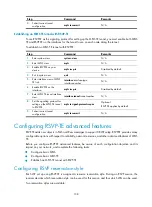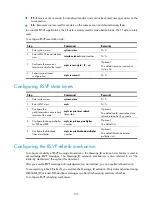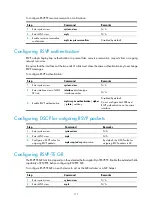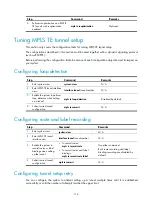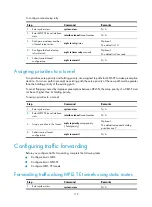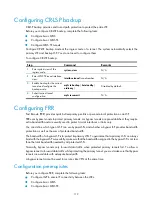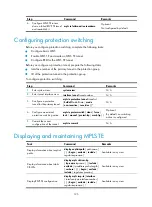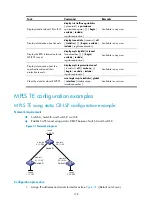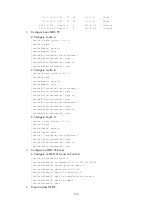
117
Configuring forwarding adjacency
To make forwarding adjacency take effect, create a bi-directional MPLS TE tunnel and enable forwarding
adjacency at both ends of the tunnel.
To configure forwarding adjacency:
Step Command
Remarks
1.
Enter system view.
system-view
N/A
2.
Enter MPLS TE tunnel interface
view.
interface tunnel
tunnel-number
N/A
3.
Enable IGP to advertise the
route of the MPLS TE tunnel to
IGP neighbors.
mpls te igp advertise
[
hold-time
value
]
Routes of MPLS TE tunnels are not
advertised to IGP neighbors by
default.
4.
Assign a metric to the MPLS TE
tunnel.
mpls te igp metric
{
absolute
|
relative
}
value
Optional.
The metrics of TE tunnels equal the
metrics of their corresponding IGP
routes by default.
5.
Submit current tunnel
configuration.
mpls te commit
N/A
6.
Exit to system view.
quit
N/A
7.
Enter OSPF view.
ospf
[
process-id
]
N/A
8.
Enable forwarding
adjacency.
enable traffic-adjustment
advertise
Disabled by default.
Configuring traffic forwarding tuning parameters
In MPLS TE, you can configure traffic forwarding tuning parameters, such as the failed link timer and
flooding thresholds, to change paths that IP or MPLS traffic flows traverse or to define type of traffic that
may travel down a TE tunnel.
You must use the configurations described in this section in conjunction with CSPF and a dynamic
signaling protocol, such as RSVP-TE.
Configuring the failed link timer
A CSPF failed link timer starts once a link goes down. If IGP removes or modifies the link before the timer
expires, CSPF will update information about the link in TEDB and stops the timer. If IGP does not remove
or modify the link before the timer expires, the state of the link in TEDB will change to up.
To configure failed link timer:
Step Command
Remarks
1.
Enter system view.
system-view
N/A
2.
Enter MPLS view.
mpls
N/A
3.
Configure the CSPF failed link
timer.
mpls te cspf timer failed-link
timer-interval
Optional.
The default is 10 seconds.

